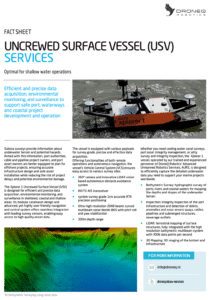
UNMANNED VESSEL USV SERVICES
The future of unmanned Surveys and Inspections is here!
The use of remotely operated and autonomous unmanned vessels, commonly known as USVs, is a safe and cost-effective way to efficiently survey and assess underwater infrastructure and assets that are not easily accessible by other means. Areas that are too shallow for the larger and manned survey vessels and potentially tight spaces are ideal for USVs, as these use ultra-high resolution underwater sonar sensors with dynamic positioning equipment to improve visual imaging and operational maneuverability.
Subsea surveys provide information about underwater terrain and potential hazards. Armed with this information, port authorities, cable and pipeline project owners, and port asset owners are better equipped to plan for marine projects, ensuring accurate infrastructure design and safe asset installation while reducing the risk of project delays and potential environmental damage.

DRONEQ ROBOTICS’ AURS UNDERWATER USV INTEGRITY SURVEY SERVICES FOCUS ON PORT & INDUSTRY, WATERWAYS AND COASTAL AREA ASSETS.
From pipelines, cables, bridge and jetty foundations, hydrodam installations, and other marine infrastructure, there are countless potential risks that lie underwater in areas such as canals, ports, and coastlines. The unmanned vessel (USV) is equipped with various payloads for accurate and effective collection of survey grade data.
Whether you need cooling water canal surveys, port asset integrity management, or jetty survey and integrity inspection, the Xplorer 1 vessel, operated by our trained and experienced personnel of DroneQ Robotics’ Advanced Unmanned Robotics Services, AURS, is designed to efficiently capture the detailed underwater data you need to support your marine projects worldwide.
- Bathymetric Survey: hydrographic survey of ports, rivers and coastal waters for mapping the depths and shapes of the underwater terrain
- Inspection: integrity inspection of the port infrastructure and detection of debris; anomalies and scour around quays, cables, pipelines and submerged structures, sewerage outfalls
- LiDAR: terrestrial mapping of surface structures, fully integrated with the high resolution bathymetric multibeam system with 300k data points per second
- 3D Mapping: 3D imaging of the bottom and infrastructure



